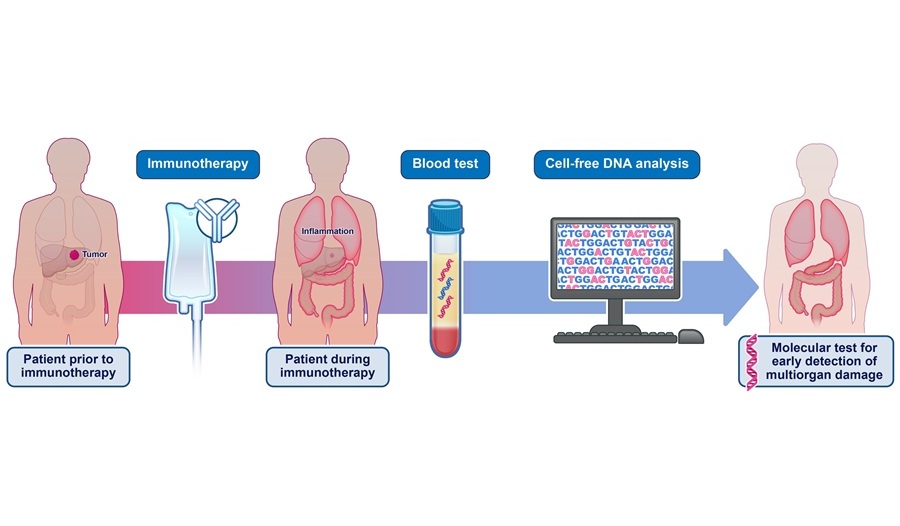Oral Cancer Detection Increased with Saliva Test
|
By LabMedica International staff writers Posted on 10 May 2012 |
A simple saliva test has been created which could identify the presence of biomarkers that are associated with oral cancer.
The easy, cost-effective saliva test to detect oral cancer would be a breakthrough that would drastically improve screening and result in fewer people dying of the world's sixth most common cancer.
A surgical team at Michigan State University (East Lansing, MI, USA) is teaming up with a local area dental benefits firm for a clinical trial of the saliva test that will aid physicians and dentists to know which patients need treatment and which ones could avoid needless and invasive biopsies. The scientists will be looking for certain biomarkers previously identified by researchers at the University of California (UCLA; Los Angeles, CA, USA). The biomarkers have been shown in studies to confirm the presence of oral cancer.
Barry Lloyd Wenig, MD, MPH, PhD, a professor of otolaryngology and lead investigator said, "Most white lesions are benign, so a majority of people who develop them are getting biopsies that are not needed. Conversely, a simple test would allow us to identify those patients with malignant lesions and get them into treatment quicker. These tests are as noninvasive as it gets; patients simply need to spit into a cup. The ease of the test will greatly expand our ability to effectively screen for the cancerous lesions. Right now, there are no early screenings available for most head and neck cancers."
Prof. Wenig is teaming up with Delta Dental (Okemos, MI, USA) which works with scientists from leading universities to monitor advances in science. Their chief science officer, Jed J. Jacobson, DDS, MPH, said, "The results of this trial could be life changing for many people. It is a tremendous opportunity for the dental community to participate in what could be a groundbreaking project.” Oral cancer has a poor survival rate linked to late detection; only 60% of patients live beyond five years after diagnosis. The survival rate is less than 38% among black males.
Related Links:
Michigan State University
University of California
Delta Dental
The easy, cost-effective saliva test to detect oral cancer would be a breakthrough that would drastically improve screening and result in fewer people dying of the world's sixth most common cancer.
A surgical team at Michigan State University (East Lansing, MI, USA) is teaming up with a local area dental benefits firm for a clinical trial of the saliva test that will aid physicians and dentists to know which patients need treatment and which ones could avoid needless and invasive biopsies. The scientists will be looking for certain biomarkers previously identified by researchers at the University of California (UCLA; Los Angeles, CA, USA). The biomarkers have been shown in studies to confirm the presence of oral cancer.
Barry Lloyd Wenig, MD, MPH, PhD, a professor of otolaryngology and lead investigator said, "Most white lesions are benign, so a majority of people who develop them are getting biopsies that are not needed. Conversely, a simple test would allow us to identify those patients with malignant lesions and get them into treatment quicker. These tests are as noninvasive as it gets; patients simply need to spit into a cup. The ease of the test will greatly expand our ability to effectively screen for the cancerous lesions. Right now, there are no early screenings available for most head and neck cancers."
Prof. Wenig is teaming up with Delta Dental (Okemos, MI, USA) which works with scientists from leading universities to monitor advances in science. Their chief science officer, Jed J. Jacobson, DDS, MPH, said, "The results of this trial could be life changing for many people. It is a tremendous opportunity for the dental community to participate in what could be a groundbreaking project.” Oral cancer has a poor survival rate linked to late detection; only 60% of patients live beyond five years after diagnosis. The survival rate is less than 38% among black males.
Related Links:
Michigan State University
University of California
Delta Dental
Latest Pathology News
- Rapid Low-Cost Tests Can Prevent Child Deaths from Contaminated Medicinal Syrups
- Tumor Signals in Saliva and Blood Enable Non-Invasive Monitoring of Head and Neck Cancer
- Common Health Issues Can Influence New Blood Tests for Alzheimer’s Disease
- Blood Test Formula Identifies Chronic Liver Disease Patients with Higher Cancer Risk
- Tunable Cell-Sorting Device Holds Potential for Multiple Biomedical Applications
- AI Tool Outperforms Doctors in Spotting Blood Cell Abnormalities
- AI Tool Rapidly Analyzes Complex Cancer Images for Personalized Treatment
- Diagnostic Technology Performs Rapid Biofluid Analysis Using Single Droplet
- Novel Technology Tracks Hidden Cancer Cells Faster
- AI Tool Improves Breast Cancer Detection
- AI Tool Predicts Treatment Success in Rectal Cancer Patients
- Blood Test and Sputum Analysis Predict Acute COPD Exacerbation
- AI Tool to Transform Skin Cancer Detection with Near-Perfect Accuracy
- Unique Immune Signatures Distinguish Rare Autoimmune Condition from Multiple Sclerosis
- Simple Optical Microscopy Method Reveals Hidden Structures in Remarkable Detail
- Hydrogel-Based Technology Isolates Extracellular Vesicles for Early Disease Diagnosis
Channels
Clinical Chemistry
view channel
Online Tool Detects Drug Exposure Directly from Patient Samples
Doctors often rely on patient interviews and medical records to determine what medications a person has taken, but this information is frequently incomplete. People may forget drugs they used, take over-the-counter... Read more
Chemical Imaging Probe Could Track and Treat Prostate Cancer
Prostate cancer remains a leading cause of illness and death among men, with many patients eventually developing resistance to standard hormone-blocking therapies. These drugs often lose effectiveness... Read moreMolecular Diagnostics
view channel
New 15-Minute Hepatitis C Test Paves Way for Same-Day Treatment
Chronic hepatitis C infection affects an estimated 50 million people worldwide and causes around 242,000 deaths each year, largely due to cirrhosis and liver cancer. Although the infection is curable with... Read more
Ovarian Cancer Assay Outperforms Traditional Tests in Early Disease Detection
Globally, ovarian cancer is one of the deadliest cancers affecting women. Traditionally, early diagnosis of ovarian cancer has been challenging. Many ovarian cancers are diagnosed only after they have... Read moreHematology
view channel
MRD Tests Could Predict Survival in Leukemia Patients
Acute myeloid leukemia is an aggressive blood cancer that disrupts normal blood cell production and often relapses even after intensive treatment. Clinicians currently lack early, reliable markers to predict... Read more
Platelet Activity Blood Test in Middle Age Could Identify Early Alzheimer’s Risk
Early detection of Alzheimer’s disease remains one of the biggest unmet needs in neurology, particularly because the biological changes underlying the disorder begin decades before memory symptoms appear.... Read more
Microvesicles Measurement Could Detect Vascular Injury in Sickle Cell Disease Patients
Assessing disease severity in sickle cell disease (SCD) remains challenging, especially when trying to predict hemolysis, vascular injury, and risk of complications such as vaso-occlusive crises.... Read more
ADLM’s New Coagulation Testing Guidance to Improve Care for Patients on Blood Thinners
Direct oral anticoagulants (DOACs) are one of the most common types of blood thinners. Patients take them to prevent a host of complications that could arise from blood clotting, including stroke, deep... Read moreImmunology
view channel
Blood Test Could Detect Adverse Immunotherapy Effects
Immune checkpoint inhibitors have transformed cancer treatment, but they can also trigger serious immune-related adverse events that damage healthy organs and may become life-threatening if not detected early.... Read more
Routine Blood Test Can Predict Who Benefits Most from CAR T-Cell Therapy
CAR T-cell therapy has transformed treatment for patients with relapsed or treatment-resistant non-Hodgkin lymphoma, but many patients eventually relapse despite an initial response. Clinicians currently... Read moreMicrobiology
view channel
Blood-Based Diagnostic Method Could Identify Pediatric LRTIs
Lower-respiratory tract infections (LRTIs) are a leading cause of illness and death worldwide, and pneumonia is the leading infectious cause of death in children under five, claiming the lives of over... Read more
Rapid Diagnostic Test Matches Gold Standard for Sepsis Detection
Sepsis kills 11 million people worldwide every year and generates massive healthcare costs. In the USA and Europe alone, sepsis accounts for USD 100 billion in annual hospitalization expenses.... Read moreRapid POC Tuberculosis Test Provides Results Within 15 Minutes
Tuberculosis remains one of the world’s deadliest infectious diseases, and reducing new cases depends on identifying individuals with latent infection before it progresses. Current diagnostic tools often... Read more
Rapid Assay Identifies Bloodstream Infection Pathogens Directly from Patient Samples
Bloodstream infections in sepsis progress quickly and demand rapid, precise diagnosis. Current blood-culture methods often take one to five days to identify the pathogen, leaving clinicians to treat blindly... Read moreTechnology
view channel
Machine Learning Models Diagnose ALS Earlier Through Blood Biomarkers
Amyotrophic lateral sclerosis (ALS) is a rapidly progressive neurodegenerative disease that is notoriously difficult to diagnose in its early stages. Early symptoms often overlap with other neurological... Read more
Artificial Intelligence Model Could Accelerate Rare Disease Diagnosis
Identifying which genetic variants actually cause disease remains one of the biggest challenges in genomic medicine. Each person carries tens of thousands of DNA changes, yet only a few meaningfully alter... Read moreIndustry
view channel
BD and Penn Institute Collaborate to Advance Immunotherapy through Flow Cytometry
BD (Becton, Dickinson and Company, Franklin Lakes, NJ, USA) has entered into a strategic collaboration with the Institute for Immunology and Immune Health (I3H, Philadelphia, PA, USA) at the University... Read more




 assay.jpg)
















